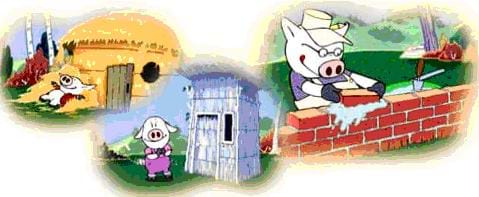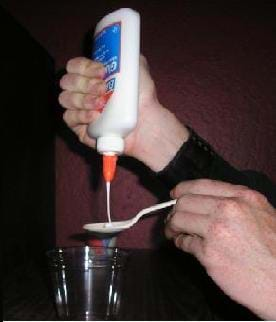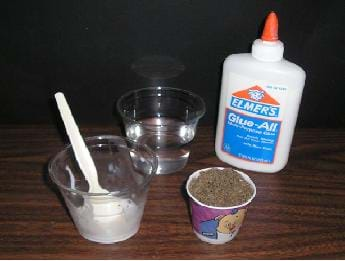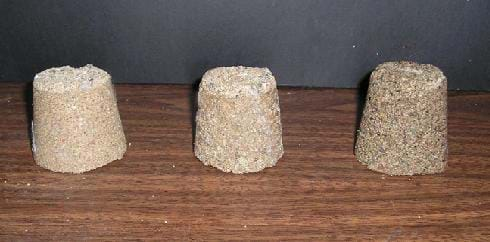Quick Look
Grade Level: 3 (3-5)
Time Required: 1 hours 30 minutes
(two class periods, spaced a few days apart)
Expendable Cost/Group: US $1.50
Group Size: 3
Activity Dependency: None
Subject Areas: Earth and Space
NGSS Performance Expectations:

| 3-5-ETS1-2 |
Summary
The purpose of this activity is to demonstrate the importance of rocks, soils and minerals in engineering and how using the right material for the right job is important. The students build three different sand castles and test them for strength and resistance to weathering. Then, they discuss how the buildings are different and what engineers need to think about when using rocks, soils and minerals for construction.
Engineering Connection
When designing structures, engineers must understand the material properties of rocks, soils and minerals and how these properties change when mixed together. Engineers must also make sure that the rocks, soils, and minerals are strong and safe enough for the job. Other material constraints might include ease of manipulation and material expense.
Learning Objectives
After this activity, students should be able to:
- Explain that combining different materials is necessary when using rocks, soils and minerals for construction.
- Explain how engineers need to consider material properties of rocks, soils and minerals when creating something new.
Educational Standards
Each TeachEngineering lesson or activity is correlated to one or more K-12 science,
technology, engineering or math (STEM) educational standards.
All 100,000+ K-12 STEM standards covered in TeachEngineering are collected, maintained and packaged by the Achievement Standards Network (ASN),
a project of D2L (www.achievementstandards.org).
In the ASN, standards are hierarchically structured: first by source; e.g., by state; within source by type; e.g., science or mathematics;
within type by subtype, then by grade, etc.
Each TeachEngineering lesson or activity is correlated to one or more K-12 science, technology, engineering or math (STEM) educational standards.
All 100,000+ K-12 STEM standards covered in TeachEngineering are collected, maintained and packaged by the Achievement Standards Network (ASN), a project of D2L (www.achievementstandards.org).
In the ASN, standards are hierarchically structured: first by source; e.g., by state; within source by type; e.g., science or mathematics; within type by subtype, then by grade, etc.
NGSS: Next Generation Science Standards - Science
| NGSS Performance Expectation | ||
|---|---|---|
|
3-5-ETS1-2. Generate and compare multiple possible solutions to a problem based on how well each is likely to meet the criteria and constraints of the problem. (Grades 3 - 5) Do you agree with this alignment? |
||
| Click to view other curriculum aligned to this Performance Expectation | ||
| This activity focuses on the following Three Dimensional Learning aspects of NGSS: | ||
| Science & Engineering Practices | Disciplinary Core Ideas | Crosscutting Concepts |
| Generate and compare multiple solutions to a problem based on how well they meet the criteria and constraints of the design problem. Alignment agreement: | Research on a problem should be carried out before beginning to design a solution. Testing a solution involves investigating how well it performs under a range of likely conditions. Alignment agreement: At whatever stage, communicating with peers about proposed solutions is an important part of the design process, and shared ideas can lead to improved designs.Alignment agreement: | Engineers improve existing technologies or develop new ones to increase their benefits, to decrease known risks, and to meet societal demands. Alignment agreement: |
Common Core State Standards - Math
-
Multiply and divide within 100.
(Grade
3)
More Details
Do you agree with this alignment?
-
Represent and solve problems involving multiplication and division.
(Grade
3)
More Details
Do you agree with this alignment?
International Technology and Engineering Educators Association - Technology
-
Test and evaluate the solutions for the design problem.
(Grades
3 -
5)
More Details
Do you agree with this alignment?
-
Evaluate designs based on criteria, constraints, and standards.
(Grades
3 -
5)
More Details
Do you agree with this alignment?
State Standards
Colorado - Math
-
Multiply and divide within 100.
(Grade
3)
More Details
Do you agree with this alignment?
-
Represent and solve problems involving multiplication and division.
(Grade
3)
More Details
Do you agree with this alignment?
Materials List
Each group needs:
- 6 bathroom-sized paper cups ("Dixie" cups)
- 1 small bowl for mixing ingredients
- 4 cups of sand
- 5 tsp. white glue
- 1 cup water
- 2 plastic spoons (about teaspoon-sized)
To share with the entire class:
- 1 permanent marker, any color
- 1 watering can
- a few bricks
- 1 can of non-stick cooking spray
- safety glasses
Introduction/Motivation
What kinds of materials are used to make buildings? Do you know? Some buildings are made of wood, stone, steel, concrete, brick or adobe (List these on the board.) Which of these come from a rock, soil or mineral? Almost all of them are directly made from rocks, soils and minerals. From the list we made, only wood is not actually a rock, soil or mineral. However, since trees need soil to grow, wood is still closely related.
When building any type of structure, engineers need to make sure they pick the right material for the job. Let's think about some examples. (Start a new list on the board of the material properties engineers consider from the examples below.) Why do you think engineers do not build airplanes out of marble? Well, marble is too heavy, and the plane might not be able to lift up into the air! So engineers use aluminum, which is still strong, but much lighter. Engineers do not always have to think about the weight of a material when building something. Why don't engineers build big skyscrapers out of wood? Wood is not strong enough to hold up such a tall structure. We can use wood to build houses, because they are shorter. So, engineers have to think about the strength of the material they are using. However, wood is still cheap and easy to work with. Why don't engineers build bridges out of diamonds? Diamonds are very strong, but they are incredibly expensive, and building a bridge out of diamonds would be very difficult. Engineers have to think about how much a material costs when they are using it as well as how easy it is to work with the material. Why don't engineers build houses out of concrete? Sometimes they do, but usually houses are built out of wood or bricks because people like the way it looks better than concrete. Engineers have to think about the way things look when building something, as appeal is a great motivator for finished products.
So, many of the materials that engineers use when they are constructing come from rocks, soils and minerals. Engineers need to know about the properties of the different materials and how to use them in order to create something that is heavy or light enough, strong, cost effective and aesthetic (looks good), as well as functional, safe and reliable. Today, we are going to create buildings out of different materials. You are going to be the engineers who figure out which materials are best for the buildings we are making, taking into consideration all the properties of materials that we have discussed.
Procedure
Before the Activity
- Gather materials.
With the Students
Part I: Building
About four days before the testing part of the activity, have the students construct four of the buildings as follows.
- Carefully measure out glue, mixing 4 tsp. of glue with 4 tsp. of water in the mixing bowl (see Figure 2).

- Add two full Dixie cups full of sand to the glue/water solution and stir until you have a completely damp sand mixture.
- Spray the inside of two bathroom cups with the non-stick spray.
- Place this mixture into the two bathroom cups so that they are nearly full (see Figure 3).

- With a permanent marker, write "B" on the sides of the bathroom cups.
- Set the cups aside so they can dry for at least four days.
- Mix 1 tsp. of white glue with 6 tsp of water in the bowl.
- Add two full bathroom cups full of sand to the glue/water solution and stir until you have a completely damp sand mixture.
- Spray the inside of two bathroom cups with the non-stick spray.
- Place this mixture into the two bathroom cups so that they are nearly full.
- With a permanent marker, write "C" on the sides of these bathroom cups.
- Set the cups aside so they can dry for at least four days.
Part 2: Testing
- Before Part 2 of the activity, make sure that the B and C labeled buildings (filled bathroom cups) are completely dry.
- Have each group mix 2 bathroom cups full of sand with 6 tsp. of water in the bowl. Have them fill the two remaining bathroom cups with this damp sand (no glue). Mark an "A" on these cups.
- Have each group take their two A, two B and two C cups outside with a watering can and a brick.
- Have each team carefully turn over one of their A cups and place it on the ground. It is best if this is done on a dirt patch, but concrete and asphalt work as well. Then have them slowly pull the cups off, leaving the damp sand (as shown in Figure 4).

- Then have one student from each group pour water on his/her building using the watering can. Ask the students what they observed. Did their buildings remain standing? What does the water from the watering can represent? (Answer: Rain or erosion.)
- Have each group set up their second A building on the ground in the same way they did with the first one. Have them try and set the brick on top of the building. Ask the students what they observed. Is the building able to hold up the brick? What do they think the brick represents? (Answer: The brick represents the weight of people, furniture and other objects [loads] that the structure must hold up. Engineers often test buildings by adding more weight to them than is realistic, since it is better to be safe than sorry. This is called a safety margin.
- Next, have students get one of their B buildings and place it on the ground. Have them tear away the cup from the sand, water and glue mixture very carefully.
- Then have one student from each group pour water on their B building using the watering can. Ask the students what they observed. Did the building remain standing? Did it hold up better or worse than the A buildings? Why did this building do better? (Answer: The glue helped hold the sand together.
- Have each group set up their second B building on the ground in the same way they did with the first one. Have them try and set the brick on top of the building. Ask the students what they observed. Does the building hold up the brick?
- For buildings that are still standing, have groups hold their bricks 6 inches above their buildings. On the count of 3, have them drop a brick on each building. Have them describe about their observations.
- Repeat steps 7-10 with the C buildings. Discuss how well the C buildings did compared to the A and the B buildings.
Assessment
Pre-Activity Assessment
Poll: Before the activity, ask all students the same question. Have students raise their hand to answer the question. Write answers on the board, and summarize (in percentages or actual number of students) who answered the same or similarly. Ask students:
- If you had to build a house out of soil, would you rather have one built out of rough sand, medium-grain silt or fine-grain clay? (Answer: While sand castles are fun to build, they are not very strong; once they dry out, they usually crumble easily. Silt-type soil is good for growing plants, but it does not hold together well enough for the creation of a building. Clay is the best option. In fact, some buildings are really made out of clay when you realize that materials such as concrete, brick and adobe have a high clay content.)
Activity Embedded Assessment
Prediction: Have students predict which buildings (A, B or C) will hold up best under water (weather) or the brick (weight) and record predictions on a sheet of paper or the board.
Group Question: During the activity, ask the groups:
- Which buildings survived the weather and weight the best? Why? (Probable answer: It is most likely that the C building survived the best. This is because sand and water do not hold together well, and the glue holds the sand together better. It is important that engineers understand the properties of rocks, soils and minerals in order to design successful structures. In this scenario, our buildings were made of sand and glue — sand being a soil and glue being composed of different minerals. In the real world, engineers design many buildings using concrete, which is a mixture of minerals, rocks and soils.)
Post-Activity Assessment
Engineering Cost Analysis: Ask students to think about the situation if they had to live in a sand house: would they want live in a house like building A, B or C? Engineers also often must consider materials cost and other factors when building a house. Which of these buildings is the most expensive to build? Have the students think about the following cost problem:
- What if it turned out that the sand costs 5 cents for one bathroom cup full, glue costs 10 cents for one teaspoon, while water costs 1 cent for one teaspoon? (Answer: Each building A was built with 3 teaspoons of water and 1 cup sand – therefore costing about 7 cents a piece. Each building B was made with 2 teaspoons of glue, 2 teaspoons of water and 1 cup of sand – therefore costing about 27 cents a piece. Each building C was made with ½ teaspoon of glue, 3 teaspoons of water and 1 cup of sand – costing 13 cents each. In this case, it is probably best to have a C building since it is much cheaper than a B building, and it works nearly as well.)
- Discuss with the students how engineers must constantly weigh the pros and cons a design to come up with the best design. For example, we could build buildings out of titanium since it is incredibly strong; however, we do not actually build them out of titanium since it is so expensive and buildings do not need to be that strong in order for us to safely live in them.
Safety Issues
- When dropping the bricks, have the other students stand back several feet to avoid getting sand in their eyes. Have the dropper wear safety glasses.
Troubleshooting Tips
Students may need help peeling the paper cups off their sand buildings
Activity Extensions
Have students build other buildings using different materials such as cement, clay, plaster and assorted soils. Test these buildings in the same way to determine which are successful and which are not. Then, discuss how these materials come from rocks, soils and minerals to reinforce their importance to engineering.
Activity Scaling
- For upper grades, purchase/borrow some large washers and have students load their structures with the washers instead of a brick. Then, have them plot the number of washers it takes to collapse each structure.
- For lower grades, it may be easier to construct the buildings for them in advance.
Subscribe
Get the inside scoop on all things TeachEngineering such as new site features, curriculum updates, video releases, and more by signing up for our newsletter!More Curriculum Like This

The purpose of this lesson is to introduce students to the basic elements of our Earth's crust: rocks, soils and minerals. They learn how we categorize rocks, soils and minerals and how they are literally the foundation for our civilization.

Students are introduced to three types of material stress related to rocks: compressional, torsional and shear. They learn about rock types (sedimentary, igneous and metamorphic), and about the occurrence of stresses and weathering in nature, including physical, chemical and biological weathering.

Students learn the basics about soil, including its formation through the cycling of the Earth's materials, as well as its characteristics and importance. They are also introduced to soil profiles and how engineers conduct site investigations to learn about soil quality for development, contaminatio...

Students learn about landslides, discovering that there are different types of landslides that occur at different speeds — from very slow to very quick. All landslides are the result of gravity, friction and the materials involved. Students learn what makes landslides dangerous and what engineers ar...
References
Trakhtenberg, Izolda. National Aeronautics and Space Administration, Goddard Space Flight Center, "Soil Science Education Homepage," National Science Foundation, grant no. 9801747, April 20, 2005, originally found at http://soil.gsfc.nasa.gov/ Accessed June 19, 2006.
U.S. Department of the Interior, U.S. Geological Survey, Science Topics – Earth Characteristics, "Rocks and Deposits," March 17, 2006, originally found at http://www.usgs.gov/science/science.php?term=1005 Accessed June 19, 2006.
WGBH Educational Foundation and Sirius Thinking, PBS Kids, Between the Lions, "Huff and Puff," originally found at http://pbskids.org/lions/huff/ Accessed June 13, 2006. https://www.pbslearningmedia.org/resource/rtttec13.ela.fdn.huffpuff/huff-and-puff/ Last accessed September 14, 2020.
Wikimedia Foundation, Inc., Wikipedia, the Free Encyclopedia, "Geology," http://en.wikipedia.org/wiki/Geology Accessed June 19, 2006.
Copyright
© 2006 by Regents of the University of Colorado.Contributors
Geoffrey Hill; Tim Nicklas; Malinda Schaefer Zarske; Janet YowellSupporting Program
Integrated Teaching and Learning Program, College of Engineering, University of Colorado BoulderAcknowledgements
The contents of these digital library curricula were developed by the Integrated Teaching and Learning Program under National Science Foundation GK-12 grant no. 0338326. However, these contents do not necessarily represent the policies of the National Science Foundation, and you should not assume endorsement by the federal government.
Last modified: September 14, 2020










User Comments & Tips